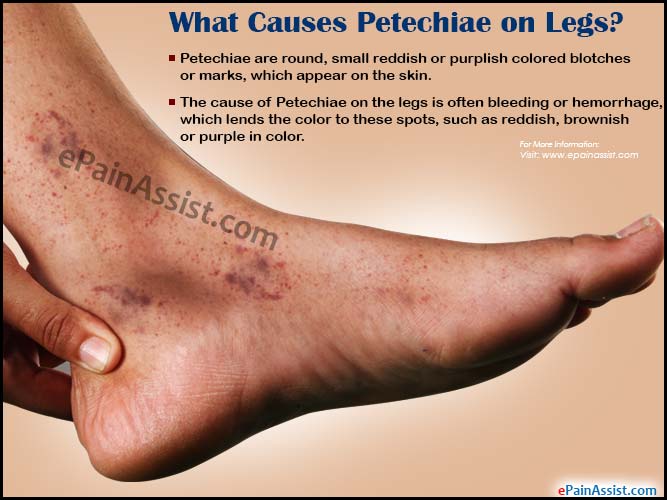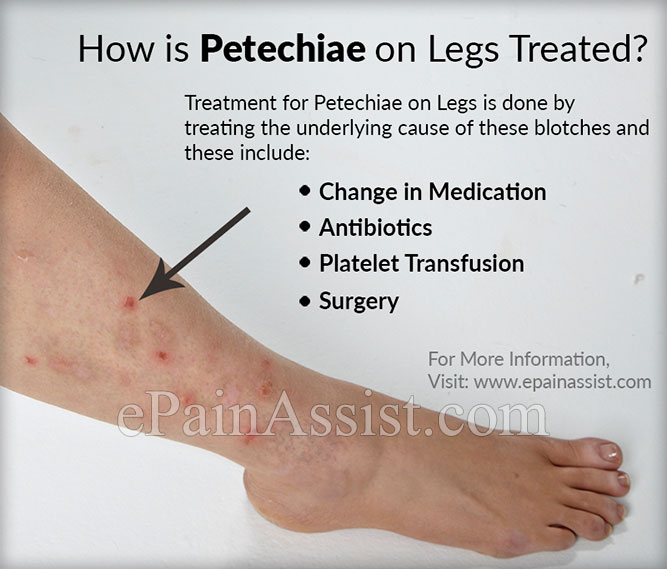What are Petechiae?
Petechiae are round, small reddish or purplish colored blotches or marks, which appear on the skin. Petechiae are about pinpoint in size and they look like spots on the skin. The cause of petechiae is minor hemorrhage, i.e. localized bleeding beneath the skin. Petechiae can also resemble a rash; however, they commonly appear in clusters. The spots of petechiae usually appear on skin of the legs, but they can also appear or spread to other parts of the body. Petechiae are often harmless and do not require any treatment and resolve on their own without needing treatment in just a few days. However, in cases where the petechiae does not disappear or resolve and continues to persist and there are other symptoms along with them, then medical help should be sought.
The cause of Petechiae on the legs is often bleeding or hemorrhage, which lends the color to these spots, such as reddish, brownish or purple in color. If the petechiae appear in clusters, then they resemble a rash on the legs.
Petechiae whether they appear on legs or other areas of the body will generally feel flat to touch and will not lose color upon pressure. In some cases, the appearance of petechiae will be in parts, such as the mouth or the eyelids.
If a person has deeper bleeding instead of superficial bleeding under the skin, then the spots will be larger and are known as bruises. Petechiae can be differentiated from extremely prominent blood vessels by application of pressure to the spot. If the redness is due to the large blood vessel, then the color will temporarily disappear with pressure, whereas in petechiae, the reddish color will not disappear with application of pressure.
If the Petechiae appear during an illness then it is a different case. If there is any bacteria present in the blood vessels, especially Meningococcus, which is the cause of spinal meningitis, then this condition can develop in the form of petechiae. In such cases, it is imperative to seek immediate medical attention, as such type of petechiae in a child or adult is an indication of an extremely fatal case of sepsis, even if the adult or the child does not appear ill whatsoever.

What Causes Petechiae on Legs?
The causes of petechiae on legs are various and include trauma, allergy, pressure and hemorrhage.
Petechiae on Legs Caused Due to Trauma/Injury: Trauma is the primary cause of petechiae spots on the legs, as well as other parts of the body. If there is application of excessive force or pressure to the body tissue, then this stress causes the development of the petechiae spots. Injury to the blood capillaries on skin can result in hemorrhage, which causes leakage of red blood cells from the capillaries resulting in their accumulation beneath the skin, which is known as petechiae. Accumulation of blood beneath the skin after an injury can be more, especially if there is no cut or opening beneath the surface of the skin for the blood to escape.
Petechiae on Legs Caused Due to Medications: There are certain medications, which cause allergic reactions resulting in appearance of petechiae on the skin. Petechiae can also develop as side effects of certain medications, such as aspirin, heparin, warfarin and cortisone.
Fever Causing Petechiae on Legs: Individuals who are suffering from fever are more likely to develop petechiae. The cause of this is often related to Meningococcus bacterium in the blood.
Petechiae on Legs Caused Due to Cancer: Bone marrow cancer and leukemia are fatal medical conditions, which lower the platelet count. This is considered as a major cause of petechiae.
Cancer Treatment Can Cause Petechiae on Legs: Petechiae can also develop on the legs as an adverse effect of chemotherapy and radiation therapy for treating cancer.
Thrombocytopenia Can Cause Petechiae on Legs: Thrombocytopenia is a disease which occurs due to decreased levels of platelet in the body and cause appearance of petechiae. Thrombocytopenia can also occur as a result of side effects of medicines, which a person takes when suffering from an infection. This impairs the function of the platelets leading to development of petechiae.
Other Causes of Petechiae on Legs: Some of the other causes for development of petechiae on the legs include autoimmune diseases and viral infections.
What are the Symptoms or Characteristics of Petechiae on Legs?
Color of Petechiae on Legs: The color of petechiae on legs initially appears as red, but over the time changes to bluish or purplish color. In the last stages, the petechiae spots change color to dark blue or a dark purple. The color of petechiae spots is usually red in the beginning then changes to brown and then purple. Sometimes, due to oxidation of blood, the petechiae spots appear as brown or dark purple.
Size of Petechiae on Legs: The size of the petechiae spots is around 1 to 2 mm. In later stages, the size of the petechiae spots does not exceed more than 0.5 cm in size.
Appearance of Petechiae on Legs: In the initial stages of the petechiae spots, they occur sparsely but gradually as their appearance and number increases they incline to cluster together. The petechiae after their initial appearance on the legs can later be appear on other parts of the body such as ankles, thigh, face, shoulders and back. Petechiae on face or facial petechiae are primarily caused from crying, coughing or vomiting with formation of red spots over the skin of the face, such as the region surrounding the eyes.
Texture: Petechiae are flat to touch and are not raised or elevated like rashes. Petechiae are flat because they develop beneath the surface of the skin and do not change color or blanch when pressure is applied on them.

How is Petechiae on Legs Treated?
Treatment for Petechiae on Legs is done by treating the underlying cause of these blotches and these include:
Treating Petechiae on Legs With Change in Medication: If the cause is a certain medication, then the patient needs to consult their physician to see what changes could be made regarding that medicine, whether the dosage could be changed or if the medication needs to be stopped.
Antibiotics: Antibiotics are prescribed if the cause of Petechiae on Legs is an infection.
Platelet Transfusion to Treat Petechiae on Legs: If the cause of Petechiae on Legs is injury to the blood capillaries, then treatment methods comprise of use of ice and platelet transfusion.
Surgery to Treat Petechiae on Legs: Surgery is required if the appearance of Petechiae on Legs is due to malignant conditions such as leukemia or cancer.
Also Read:
